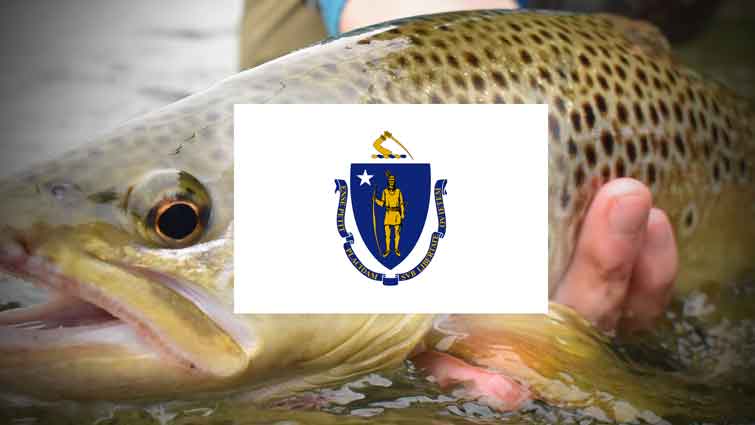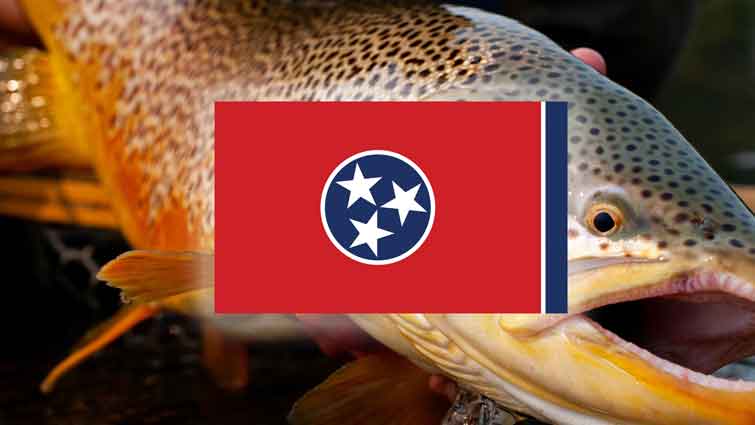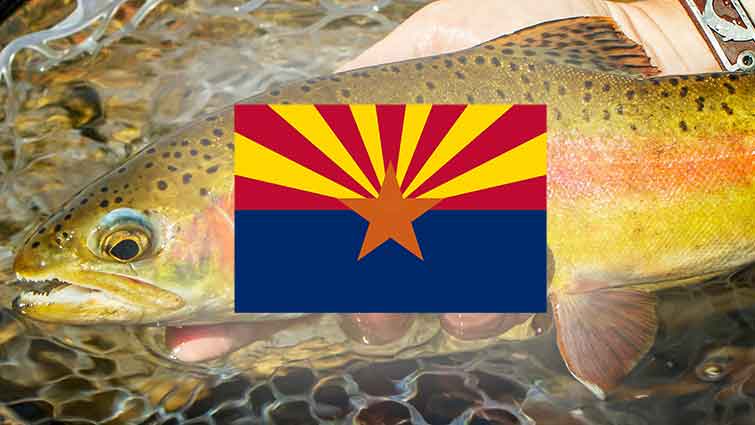Massachusetts provides anglers with ample opportunities to fly fish in various environments. Because of the state's diverse topography, fly fishers can find everything from small streams and ponds to large rivers and lakes.
As a whole some of the best places to fly fish in Massachusetts include:
- Swift River
- Deerfield River
- Newburyport’s Plum Island
- Housatonic River
- Flats at Provincetown Harbor
- Squannacook River
- Housatonic River, Lee, MA and more
Massachusetts is home to a variety of different fish species, including trout, bass, and stripers. Both saltwater and freshwater fly fishing are popular in the state, and in this article, we'll look at both types of locations and what they offer anglers.

Best Fly Fishing locations in Massachusetts
Fly fishing in Massachusetts can be found in various locations, including rivers, lakes, ponds and coastal lines.

1. Swift River
Some of the best trout fly fishing in the state can be found in the Swift River, located in the central part of Massachusetts. It has three branches: an east branch, a west branch, and a middle branch, and it is a tributary of the Ware River.
The Quabbin Reservoir is formed by damming part of the river valley near it to create the reservoir, which serves Boston and Eastern Massachusetts. This river is stocked with trout every year, making it a popular destination for anglers.

Recommended Fly Patterns for the Swift River, Massachusetts:

2. Deerfield River
The Deerfield River is another great option for trout fly fishing, and it's located in the western part of the state. The Deerfield River, which runs for 76 miles from southern Vermont to the Connecticut River, is a river that was historically important in the colonization of western Franklin County, Massachusetts. The Deerfield River is the second-longest tributary of the Connecticut River in Massachusetts, at 2.1 miles (3.4 km) shorter than Springfield's Westfield River.

Recommended Fly Patterns for the Deerfield River, Massachusetts:

3. Newburyport’s Plum Island
Plum Island is a long, narrow barrier island off the northeast coast of Massachusetts in the United States. It is around 11 miles (18 km) long. The name comes from the wild beach plum bushes that cover its dunes, but it is also known for the pink pyrope garnet sand at high tide, which gets its color from tiny crystals of pink pyrope garnet.
It lies split between Newburyport on the north and Newbury on the south, as well as Ipswich to the west and Rowley to the east.
Plum Island, located less than five miles south of the New Hampshire border, is an excellent destination for shore-fishing in New England. Unlike most fishing spots on the Boston North Shore, access around Plum Island is very accessible.

Recommended Fly Patterns for the Newburyport’s Plum Island, Massachusetts:
- Surf Candy - Size 2/0 and 3/0
- Clouser Minnow in Various Color - 4 to 1/0
- Sand Eel FLY - Size 1/0 and 2

4. Housatonic River
The Housatonic River is a river in western Massachusetts and southwestern Connecticut in the United States, approximately 149 miles (240 km) long. It flows south to southeast and drains around 1,950 square miles (5,100 km2) of southwestern Connecticut into Long Island Sound. To the west is the lower Connecticut River's watershed.
The Housatonic River, which runs through Litchfield County, Connecticut, is one of the best trout rivers in the eastern United States. Between Falls Village and Cornwall Bridge, the most popular region for fly fishing is Litchfield County, Connecticut.

Recommended Fly Patterns for the Housatonic River, Massachusetts:

5. Flats at Provincetown Harbor
The flats at Provincetown Harbor offer some of the best saltwater fly fishing in Massachusetts. This is a great place to target striped bass, bluefish, and other saltwater species. The flats can be accessed by boat or from the shore, and several charter companies offer guided trips in the area.
Provincetown Harbor is a large natural harbor in Provincetown, Massachusetts. The harbor is generally 30 to 90 feet (9 to 27 m) deep and covers roughly 1 mile (1.6 km) from northwest to southeast and 2 miles (3.2 km) from northeast to southwest, with one huge, deep basin without any dredged channel required for boats to enter and leave.

Recommended Fly Patterns for the Flats at Provincetown Harbor, Massachusetts:
- Surf Candy - Size 2/0 and 3/0
- Sand Eel FLY - Size 1/0 and 2
- Clouser Minnow White/Green - Size #2

6. Squannacook River
The Squannacook River is a 16.4-mile-long (26.4 km) river in northern Massachusetts that flows into the Nashua River and is part of the Merrimack River watershed. Brook trout fishing on tributaries of the Squannacook River can be quite successful. It has several little tributary streams that are frequently replenished.
The river is formed by five streams: Trapfall Brook, Willard Brook, Locke Brook, Walker Brook, and Mason Brook. Each of these is stocked with brook trout and maintains holdovers and wild brook trout. Two additional tributaries containing trout are Witch Stream and Bixby Creek. There are several other tributaries where trout survive but aren't stocked.
The Squannacook River begins in Townsend and West Groton, Massachusetts, and flows into the Nashua River just east of Woodsville; it is dammed three times in Townsend and twice in West Groton.
It has been given the designation Outstanding Resource Water because of its 73-square-mile (190-km2) watershed, 18 percent of which is permanently protected. It has been designated an Outstanding Resource Water by the state government.

Recommended Fly Patterns for the Squannacook River, Massachusetts:
- Zebra Midge Red - Size 20
- Copper John Beadhead - Copper - Size 18
- Prince Nymph Jig Beadhead - Size 12

7. Housatonic River, Lee, MA
The Housatonic River runs south from the confluence of the East and West Branches of the river in Pittsfield, Massachusetts. The main trunk of the Housatonic River flows south from its source in Pittsfield.
The upper Housatonic River Catch-and-Release Area section begins at Route 20 overpass near Lee and extends 1½ miles to Willow Mill Dam. The Housatonic River Catch-and-Release Area may hold coldwater fish like trout throughout the year, including in both sections.
In the summer, as water temperatures rise, certain parts of the river become too hot for trout, and warm water species take up more of the catch. Fish surveys have revealed multiple species in the upper Housatonic Catch-and-Release Area, include:
- Rock bass
- Smallmouth and largemouth bass,
- White sucker,
- Brown trout
- Yellow perch, and
- Bluegill
All the species that live in the upper section are also supported by the lower region, adding:
- Rainbow Trout
- Fallfish
- Common Shiner, and
- Northern Pike.

Recommended Fly Patterns for the Housatonic River, Lee, MA, Massachusetts:
- Kaufman Stone - Golden - Size 8
- Copper John Hot Wire Beadhead - Red Gold - Size 12
- Pheasant Tail Jig Natural - Tungsten - Barbless - Size 12

8. Boston Harbor Islands, Boston, MA
Boston Harbor Islands National and State Park, which comprises 34 islands and peninsulas, is an urban retreat just minutes from downtown Boston. The Boston Harbor Islands National Recreation Area is a national recreational area that includes the islands of Boston Harbor in Massachusetts.
The territory is made up of several islands, including a former island plus a peninsula, several of which are open to the public and others of which are tiny and best utilized by wildlife. The Boston Harbor Islands Partnership governs the region. Castle Island, Revere Beach, and Squantum Point Park are some of the best spots for fly fishing in the state. You can expect to find bass, bluefish, flounder, and striped bass in the area.

Recommended Fly Patterns for Boston Harbor Islands, Massachusetts:
- Surf Candy - Size 2/0 and 3/0
- Clouser Minnow White/Green - Size 2
- Double Bunny Black and Olive - Size 6

9. Chappaquiddick Island, Martha’s Vineyard, MA
Chappaquiddick Island, informally known as "Chappy," a portion of Edgartown, Massachusetts's town, is a tiny peninsula and occasional island on the eastern edge of Martha's Vineyard. Between Katama and Wasque, Norton Point, a narrow barrier beach, connects Martha's Vineyard with Chappaquiddick.
Hurricanes and powerful storms occasionally separate the islands for periods of time, causing rare gaps. Most of its beaches can be accessed by 4WD.
The nice thing about Chappy is that it has so many excellent fishing locations and several distinct types of water — big surf on the South side, the rips at Wasque Point, inlet fishing at the Gut and Tom's Neck, cusps and bowls of East beach, and two huge saltwater ponds in Pocha and Cape Poge. In terms of species, bluefish and striped bass appear in early May.

Recommended Fly Patterns for Chappaquiddick Island, Massachusetts:
- Surf Candy - Size 2/0 and 3/0
- Clouser Minnow in Various Color - 4 to 1/0
- Sand Eel - Size 1/0 and 2

10. Connecticut River
The Connecticut River is the single longest river in the New England area of the United States, flowing for 406 miles (653 km) through four states. It rises 300 yards south of the border between the United States and Canada and discharges into Long Island Sound.
Its basin covers 11,260 square miles (29,200 km2), split between five American states and a Canadian province with 148 tributaries, 38 of which are large rivers.
The Connecticut River reaches its greatest depth, 130 feet (40 m) at Gill, Massachusetts, around the French King Bridge. Fishing is a very popular pastime in the river, with many different fish species. American shad, Atlantic salmon, smallmouth and largemouth bass, northern pike, walleye, and yellow perch are the most common.

Recommended Fly Patterns for the Connecticut River, Massachusetts:

11. Charles River
The Charles River is an 80-mile-long (129 km) river in eastern Massachusetts, flowing northeast from Hopkinton to Boston along a mostly meandering course that doubles back on itself several times and goes through 23 towns before emptying into the Atlantic Ocean.
The Charles River is home to a diverse range of freshwater fish species and some diadromous ones. The redfin pickerel, largemouth bass, golden shiner, yellow perch, several sunfish (including bluegills, redbreast sunfish, and pumpkinseeds), and various catfish species are among the most frequent freshwater fish in the Charles River.

Recommended Fly Patterns for the Charles River, Massachusetts:

12. Millers River
The Millers River is a 52.1-mile (83.8 km) river in northern Massachusetts that begins in Ashburnham and merges with the Connecticut River near Millers Falls, just downstream from the dam. The section of the river upriver is utilized for whitewater kayaking, and a portion of it is popular with flatwater speedsters (canoe racing), while the river is locally known as an excellent venue for pike fishing.
The most remote section of this river begins at a bridge on South Ralston downstream to the Starret Factory Dam at the east end of Athol. This flows through land that is preserved and has yet to be developed, making it ideal for fly fishing.

Recommended Fly Patterns for the Millers River, Massachusetts:

13. Quabbin Reservoir
Quabbin Reservoir is one of the biggest unfiltered water sources in the United States. It feeds high-quality water to the Massachusetts Water Resources Authority's water supply system, including the Wachusett Reservoir and Ware River. With a capacity of 412 billion gallons, it covers 39 square miles and has 181 kilometers of shoreline.
The Quabbin fishing season begins on April 16 (weather permitting). It lasts until October 15, with multiple species, including largemouth and smallmouth bass, black crappie, rainbow trout, brown trout, lake trout, bluegill, pumpkinseed sunfish, white perch, and yellow perch.

Recommended Fly Patterns for the Quabbin Reservoir, Massachusetts:
- Slump Buster with Cone - Olive - Size 6
- Double Bunny Black and Olive - Size 6
- Muddy buddy - Olive - Size 6

14. The Oxbow
The Oxbow, also known as the Ox-Bow, is a small river that extends from the Connecticut River in Northampton, Massachusetts, into Connecticut. The Oxbow may easily reach off of I-91 by taking exit 18 and bearing left onto Dike Road. Largemouth bass, Northern pike, and Chain pickerel are the most frequent species caught in this region.

Recommended Fly Patterns for the The Oxbow, Massachusetts:

15. Cape Cod Kettle Ponds
Kettle ponds are located all across the outer Cape Cod region, made up of glacial outwash plains formed after the Laurentide ice sheet receded some 18,000 years ago. The ponds were created when depressions in the outwash plains became blocked with sediment, preventing runoff water from draining.
The Cape's kettle ponds are home to various fish, including largemouth bass, smallmouth bass, trout, pickerel, sunfish, and perch. These ponds make for great fly fishing spots as they are relatively shallow and clear, allowing anglers to spot fish.

Recommended Fly Patterns for Cape Cod Kettle Ponds, Massachusetts:

16. Wachusett Reservoir
The Wachusett Reservoir is a reservoir in central Massachusetts that supplies water to greater Boston. It is located in the towns of Clinton, Holden, Paxton, Princeton, Sterling, and West Boylston. The reservoir is fed by the Chicopee River and Millers River and has a capacity of 65 billion gallons.
The Wachusett Reservoir is home to various fish species, including largemouth bass, smallmouth bass, rainbow trout, brown trout, lake trout, bluegill, pumpkinseed sunfish, white perch, and yellow perch.

Recommended Fly Patterns for the Wachusett Reservoir, Massachusetts:
- Zonker - Grizzly - Size 10
- Muddy buddy - Black - Size 6
- Clouser Minnow White/Green - Size #2

17. Lake Onota
Lake Onota is a glacial lake located in the Berkshires of western Massachusetts, fed by several small streams and underground springs. Onota Lake is located in Pittsfield, Massachusetts. It covers 617 acres (2.50 km2), all of which are in the city of Pittsfield, and the city owns it.
It is divided into two basins due to a historic road that marked the northern end with little water exchange between them. It empties via Onota Brook, which flows southeast into Pittsfield's West Branch of the Housatonic River.

Recommended Fly Patterns for the Lake Onota, Massachusetts:
What Gear do I need to Fly Fish in Massachusetts?
To fly fish in Massachusetts, you will need a few key items of gear. First, you will need a fly rod and reel. You can purchase these items separately or as a combo and a wide selection of flies.
Polarized sunglasses are key when fly fishing in Massachusetts, as they will help you to see fish in the water. Waders or hip boots are another essential piece of gear, but most importantly, you will need a Massachusetts fishing license, which can be obtained online or at any bait and tackle shop.
Additional Facts about Fly Fishing in Massachusetts
Can you fly fish in Massachusetts?
You can catch a variety of fish species when fly fishing in Massachusetts, including largemouth and smallmouth bass, rainbow trout, brown trout, and more. A Massachusetts fishing license is required in order to fly fish in the state. You can obtain a license online or at any bait and tackle shop.
Fly fishing is a popular pastime in Massachusetts, as the state has a wide variety of freshwater streams, rivers, and ponds to choose from. Saltwater fly fishing is also possible in Massachusetts, as there are many coastal areas to fish.
Where is the best fly fishing in New England?
Fly fishing in New England can be enjoyed in a variety of locations, including the state of Massachusetts. Some of the best fly fishing spots in Massachusetts include the Wachusett Reservoir, Lake Onota, and Cape Cod Kettle Ponds.
The Upper Connecticut Region of New Hampshire is one of the best fly-fishing locations in the Eastern United States. The source of the Connecticut River near the Canadian border is particularly good for fly fishing.
What months are best for fly fishing?
The months of April and October are peak periods for fly fishing. It is, however, a year-round sport for fly fishermen who are willing to brave the cold. In Massachusetts, trout season runs year-round.
What flies are in season for fly fishing?
The type of fly you use will depend on the time of year and the fish you are trying to catch. Some common flies used when fly fishing in Massachusetts are midges and small nymphs. Remember to match the hatch, meaning use a fly that resembles the insects the fish are currently feeding on.
When it comes to fly fishing in Massachusetts, there are a number of great locations to choose from. Some of the best spots for fly fishing in the state include the Wachusett Reservoir, Lake Onota, and the Cape Cod Kettle Ponds. Remember to obtain a Massachusetts fishing license before you head out to fish, and be sure to match the hatch when choosing your flies!






